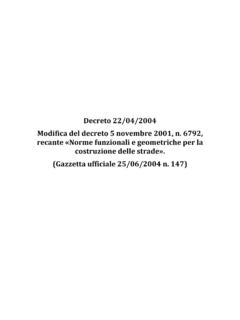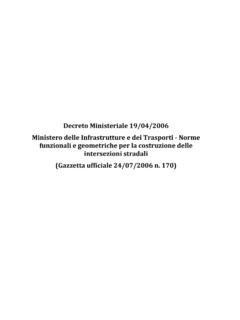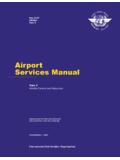Transcription of A risk assessment procedure for the safety …
1 A risk assessment procedure for the safety management of airport infrastructures Sascia Canale Department of Civil and Environmental Engineering, University of Catania, Catania, Italy Natalia Distefano Department of Civil and Environmental Engineering, University of Catania, Catania, Italy Salvatore Leonardi Department of Civil and Environmental Engineering, University of Catania, Catania, Italy SYNOPSIS Today, the overall yearly number of accidents, incidents and serious incidents in civil aviation is some 50 worldwide, with an average of 13000 victims. Experience has demonstrates that before an accident occurs various incidents and numerous failures reveal the existence of safety risks. In this context, risk assessment and risk management are important tools for understanding risks, defining acceptable levels of risks, and reducing risks. Risk management is the systematic application of management and engineering principles, criteria and tools to optimize all aspects of safety within the constraints of operational effectiveness, time, and cost throughout all mission phases.
2 Risk assessment is the process which associates hazards with risks . When we know the various impacts a hazard may have on our mission and an estimate of how likely it is to occur we can now call the hazard a risk. Risk is the probability and severity of loss from exposure to the hazard. The assessment step is the application of quantitative or qualitative measures to determine the level of risk associated with a specific hazard. This process defines the probability and severity of hazard based upon the exposure of personnel or assets to that hazard. The outcome of the risk assessment process is a list of risks developed from the output of the hazard identification process. The first risk is the most serious threat to the mission, the last is the least serious risk of any consequence. Each risk is either labeled with its significance (high, medium, etc.) or the section in which it is place is labeled.
3 This allows us to see both the relative priority of the risks and their individual significance. In this paper the authors propose an original risk assessment procedure for any airport . The original points in this methodology are: the causes identified associated with each hazard by analysing other studies and both National and International databases; the hazard probability assessment through to the cumulative probability of the causes identified using the Total probability theorem; the conditional probability assessment was established by analysing the National database for causes belonging environmental and surface conditions categories and by analyzing the International database for causes belonging aircraft performance characteristics category; hazard severity assessment was established by analysing of National database. A risk assessment procedure for the safety management of airport infrastructures In the last 10 years the number of accidents in civil aviation has remained almost constant.
4 It is feared that the proposed incline in air traffic will result in an unacceptable increase in the number of accidents in the new future. Experience has demonstrates that before an accident occurs various incidents and numerous failures reveal the existence of safety risks. In this context, the risk assessment procedure consent the determination of the probability of the causes that generate accidents, and becomes an operative instrument, particularly efficient in the prevention of hazards. In this study the authors propose an original risk assessment procedure for any airport . In particular the criteria will be provided for the assessment of the probability that the causes generate hazard. Furthermore a qualitative classification will be proposed to define the level of severity associated with the events. The elaboration of the procedure of risk management will rely on statistic analysis of data take from National and International databases.
5 The final objective of this research group is to propose criteria for risk assessment directly pertinent to a specific airport . In this regard the authors wish to draw attention to the fact that some risk assessment procedures are frequently not specific to the airport studied. RISK management PROCESS System safety is a specialty within system engineering that supports program risk management . It is the application of engineering and management principles, criteria and techniques to optimize safety . The goal of System safety is to optimize safety by the identification of safety related risks, eliminating or controlling them by design and/or procedures, based on acceptable system safety precedence. The causes of an accident are factors, events, acts, or unsafe conditions which singly, or in combination with other causes, result in the damage or injury that occurred and, if corrected, would have likely prevented or reduced the damage or injury.
6 A hazard is any condition, event, or circumstance, which could induce (cause) an accident. Risk is defined as the probability that an event will occur. A risk is the combination of the probability, or frequency, of occurrence of a defined hazard and the severity of the consequences of the occurrence . A risk is thus an attribute of a hazard. There are many types of risk, but in this study, risk is categorized into three types: Initial Risk, Current Risk, and Residual Risk. Initial Risk is the severity and likelihood of a hazard when it is first identified and assessed. It is used in the beginning or very preliminary stages of a decision, program or analysis. Initial Risk is determined by considering both verified requirements and assumptions made about system state. Once the initial risk is established it not changed. Typically, Initial Risk is an assessment formed and kept within the purview of system safety .
7 Current Risk is the predicted severity and likelihood of a hazard as it exists currently, using both validated requirements and verified requirements. Current Risk may change over time based on actions taken by the decision maker that relate to the validation and/or verification of the requirements or controls associated with the hazard. Residual Risk is the risk that remains after all requirements have been implemented or exhausted and all requirements have been verified. Only verified requirements or controls can be used to assess Residual Risk. When conducting an analysis, Predicted Residual Risk is the term used prior to formal verification of requirements or controls based on the assumption that validated and recommended safety requirements will be verified. Risk assessment and risk management are important tools for understanding risks, defining acceptable levels of risks, and reducing risks.
8 Risk management (RM) is based on the philosophy that it is irresponsible and wasteful to wait for an accident to happen, then figuring out how to prevent it from happening again. We manage risk whenever we modify the way we do something to make our chances of success as great as possible, while making our chances of failure, injury or loss as small as possible. It s a commonsense approach to balancing the risks against the benefits to be gained in a situation and then choosing the most effective course of action. Risk management is the systematic application of management and engineering principles, criteria and tools to optimize all aspects of safety within the constraints of operational effectiveness, time, and cost throughout all mission phases. To apply the systematic risk management process, the composite of hardware, procedures, and people that accomplish the mission or produce mishaps, must be viewed as a system.
9 Risk management must be a fully integrated part of planning and executing any operation, routinely applied by management , not a way of reacting when some unforeseen problem occurs. Careful determination of risks, along with analysis and control of the hazards they create results in a plan of action that anticipates difficulties that might arise under varying conditions, and predetermines ways of dealing with these difficulties. Managers are responsible for the routine use of risk management at every level of activity, starting with the planning of that activity and continuing through its completion. The goals of risk management are: To derive the values of likelihood and severity of consequence for each hazard. These will, in general, not be precise values, but rather an informed judgement as to order of magnitude . To use that information as a means of prioritising actions, which hazard requires the most work and so should be tackled first?
10 To specify mitigating features as appropriate to each hazard. To predict the effectiveness of those features in reducing the risk. The last two points are usually extended to the specification of, and selection from, a number of mitigating strategies, possibly as part of a wider cost benefit analysis. To stand any chance of achieving these goals we first need a list of hazards; a necessary precursor is thus hazard identification. When building a large system from a number of smaller ones we find that many of the hazards arise from the intra-system interfaces. When performing a risk management , then, we can start off by identifying those interfaces and the hazards arising from them. Where a system is made up of subsystems from different suppliers their domains of influence also need to be considered. The overall system owner needs to be able to coordinate and disseminate hazard identification information.














